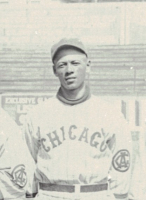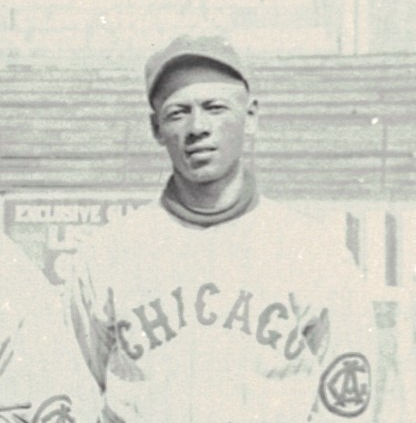Tom Williams
 Thomas Williams’s pitching career spanned only eight years, but in that time he proved to be an important member of Rube Foster’s Chicago American Giants teams in the early years of the Negro National League. Although not much is documented about Williams’s early life, he was born on September 28, 1896, in Charleston, South Carolina, to Andy Williams and Caroline Pryer.1 By 1914, at the age of 18, he was enrolled at Morris Brown College, a historically Black institution, in Atlanta. Williams was a star pitcher on the school’s baseball team and threw two no-hitters during the 1914 season alone, one against Alabama’s Tuskegee University.2 It is possible that, despite his young age, Williams was already a sophomore, as one article noted that Williams was “in midseason form,” the comparison implying that this was not his first campaign.3
Thomas Williams’s pitching career spanned only eight years, but in that time he proved to be an important member of Rube Foster’s Chicago American Giants teams in the early years of the Negro National League. Although not much is documented about Williams’s early life, he was born on September 28, 1896, in Charleston, South Carolina, to Andy Williams and Caroline Pryer.1 By 1914, at the age of 18, he was enrolled at Morris Brown College, a historically Black institution, in Atlanta. Williams was a star pitcher on the school’s baseball team and threw two no-hitters during the 1914 season alone, one against Alabama’s Tuskegee University.2 It is possible that, despite his young age, Williams was already a sophomore, as one article noted that Williams was “in midseason form,” the comparison implying that this was not his first campaign.3
The press also dubbed the ace “Cyclone,” likely as a homage to the brilliant Cyclone Joe Williams (perhaps better-known today as Smokey Joe), who had starred in Black baseball for nearly a decade. The moniker was an apt one, at least in the purview of his Southern Intercollegiate Athletic Conference (SIAC) competition.4 In an early 1915 game against Morehouse, “Cyclone Williams was on the mound for the (Morris Brown) Giants and was almost invincible. … Cyclone Williams whiffed sixteen of the Baptist boys.”5 In both 1915 and 1916, Morris Brown won the SIAC in their first two seasons of baseball competition, and in 1916 Morris Brown hosted Washington’s Howard University for a national championship of sorts.6 “In one of the greatest games that has ever been played in Atlanta, the fast Howard University aggregation met and defeated Morris Brown … 4 to 1. … ‘Cyclone’ Williams and [an otherwise unidentified catcher named] Addison formed the battery for the home team.”7
Williams’s baseball career took a turn in 1916 when he signed to play with the Bacharach City Giants, newly relocated from Jacksonville, Florida, to Atlantic City, New Jersey, while still enrolled at Morris Brown. His time there lasted only a few games. The next year he signed with Foster’s American Giants, and he pitched well enough for the 1917 champions.8 Williams was probably the number-two pitcher on the staff, behind Dick “Cannonball” Redding (another Morris Brown product), but this was a team that also had hurlers the caliber of Frank Wickware and Tom Johnson, the latter posting a 7-3 season record and a 2.57 ERA.9
Throwing almost exclusively to catcher George “Tubby” Dixon, and employing an arsenal of pitches that included “drop, spitter, fastball, and slow ‘floater,’”10 Williams is credited with 13 wins (against two losses) for the year. According to military draft registration records from 1917, he was married and lived at an address in south Chicago.11 His wife’s name is unknown, and by the time of the 1920 census, he was living alone in a boarding house in Philadelphia.12 Regardless of marital status, Williams hit the road and joined a number of his American Giants teammates over the 1917-1918 winter by pitching for the Royal Poinciana Hotel team in the Florida Hotel League.
In early 1918, Williams arrived at the American Giants’ train at the start of a road trip smelling of alcohol. Williams had a reputation for tippling, but manager Rube Foster had no patience for alcohol abuse.13 Without work, Williams returned to Atlanta for a bit, even umpiring a game between Morehouse and Clarke Universities in early April.14 Forced to find a job on the quick, the 21-year-old Williams spent 1918 and 1919 moving among John Henry “Pop” Lloyd’s Brooklyn Royal Giants, Ed Bolden’s Hilldale Daisies, and the Atlantic City Bacharach Giants.
In one particularly notable game, on September 14, 1918, Williams had the opportunity to test himself against the best players in the organized major leagues when he took the mound in a rare contest between Hilldale and the all-White World Series champion Boston Red Sox. The pitcher used his notorious pickoff move in the first inning to put Sherry Magee into a rundown between first base and second, but the Daisies failed to cover second, and Magee later scored on George Burns’s single to center field. Williams gave up two more runs in the third, and the go-ahead run in the eighth to make the score 4-3, Boston. It was for naught, though, as a ninth-inning controversy resulted in a Boston forfeit and a 9-0 Hilldale win.15
All was forgiven, it seemed, when Williams rejoined the American Giants in the newly organized Negro National League in 1920. On a chilly April 11, he took the mound in the season opener against a White semipro team called the Rogers Parks. Although Chicago lost the game on a three-run fielding error, the 4,500 in attendance were privileged to watch the first foray of Rube Foster’s new league.16 On June 6 Williams tossed a six-hitter at the Magnets of Chicago, contributing to a 12-1 win at Schorling Park.17 A week later, on June 13, he held the rival ABC’s to five hits in a 9-1 American Giants victory.18
Over the following weeks, Williams enjoyed a run of success that led to wins over the Kansas City Monarchs, the St. Louis Giants, and the Dayton Marcos. Finally, on August 1, his luck gave out in a 5-4 extra-inning loss to Bullet Rogan and the Kansas City Monarchs, this time in the latter’s home park.19 For that inaugural season, Williams posted a 12-4 record and a 1.83 earned-run average in 157 innings, and logged 15 complete games. His ERA+ of 163 showed that he was well above league average in that department.20 Interestingly, his 1.83 ERA was sandwiched between those of two teammates, with Dave Brown’s 1.82 mark on one side, and Tom Johnson’s 1.84 on the other.
Williams again pitched well in 1921, with a 14-8 record (2.87 ERA) in 163 innings pitched. In both years, 1920 and 1921, Chicago won the league title in convincing fashion. Despite the success, however, 1922 found Williams reunited with Dick Lundy with the independent Bacharach Giants in Delaware, and later in the year with the original Cyclone Joe Williams and his New York Lincoln Giants.
Back in Chicago as a reliever for the 1923 American Giants, Williams again had the chance to pitch against White major leaguers in a two-inning stint against the Detroit Tigers (with Heinie Manush, but without Ty Cobb). It was not a happy afternoon, as the pitcher yielded a bases-clearing triple in the ninth that contributed to a 7-1 drubbing by the Tigers.21
In 1924, despite waning skills, Williams still found ways to occasionally rekindle the magic. In May he tossed a two-hit complete-game against the Cleveland Browns, winning 5-1.22 But in early August, in one of several examples of his lagging success, Williams appeared in relief against the Kansas City Monarchs and gave up four runs in a Chicago loss.23
In 1924, probably due to a NNL rule that teams could no longer indefinitely reserve an excessive inventory of players, Rube Foster released a number of veterans, including Williams.24 Only 27 years old, the pitcher signed with his 1917 catcher, Bruce Petway, and the Detroit Stars.25 Williams finished the 1924 season with Detroit, but no documentation has been found that he ever pitched again.
On January 30, 1937, a small notice headlined “Tom Williams, Ace Pitcher for Foster, Is Dead” appeared in the Chicago Defender. The obituary noted that Williams died in a Chicago area hospital after enduring an unspecified, lingering illness.26 He had died at the age of 40 on January 19 in Bremen, Illinois, a Chicago suburb, and was buried in Restvale Cemetery in Alsip, Illinois. That site is also the final resting place for basketball star Nate “Sweetwater” Clifton as well as musical immortals Muddy Waters, Kansas Joe McCoy, and Luther Tucker.27
Sources
Statistical data is taken from the website www.seamheads.com, unless otherwise noted.
Notes
1 Online: Ancestry.com. Illinois, U.S., Deaths and Stillbirths Index, 1916-1947 [database online]. Provo, Utah, USA.
2 “Negro Twirler Hurls Fine No-Hit Game,” Atlanta Constitution, April 5, 1914: 13.
3 “Negro Twirler Hurls Fine No-Hit Game.”
4 Online: Southern Intercollegiate Athletic Conference – BR Bullpen (baseball-reference.com). Accessed June 3, 2021.
5 “Morris Brown 9, Morehouse 5,” Atlanta Constitution, March 27, 1915: 6.
6 “Play for Championship,” Atlanta Constitution, April 7, 1916: 10.
7 “Howard 4, Morris Brown 1,” Atlanta Constitution, April 19, 1916: 8.
8 Online: 1917 Chicago American Giants – Seamheads Negro Leagues Database. Accessed June 3, 2021.
9 “Tom Johnson,” Seamheads.com, https://www.seamheads.com/NegroLgs/player.php?playerID=johns01tom.
10 James A. Riley, “Thomas Williams,” The Biographical Encyclopedia of the Negro Baseball Clubs (New York: Carroll & Graf, 1994), 862.
11 Thomas Williams draft registration card, dated June 5, 1917. Online: 1917ThomasWilliamsWWIDraftRegistration (bravehost.com). Accessed June 4, 2021.
12 Fourteenth Census of the United States: 1920 – Population; Philadelphia Pennsylvania, Supervisor District 1, Enumeration District 1790, sheet 2B; January 3, 1920.
13 Paul DeBono, The Chicago American Giants (Jefferson, North Carolina: McFarland & Company, 2011), 66.
14 “Morehouse 19, Clarke 5,” Atlanta Constitution, April 7, 1918: 7.
15 Bill Nowlin, “The One Time the ‘Boston Red Sox’ Played a Black Team,” Baseball Research Journal, Spring 2021, (Phoenix: Society for American Baseball Research).
16 “Rogers Parks Start Semi-Pro Season by Downing Giants, 4-2,” Chicago Tribune, April 12, 1920: 11. See also Dave Wyatt, “Foster’s Crew Are Trounced,” Chicago Defender, April 17, 1920: 9, and “Foster Raises the Lid,” Chicago Whip, April 17, 1920: 5.
17 “Magnets Are Easy for Giants,” Chicago Defender, June 12, 1920: 9.
18 “Amer. Giants, 9; A.B.C., 1,” Chicago Tribune, June 4, 1920: 19. Both the Defender and Tribune box scores showed the pitcher as “B. Williams” though the Defender story specifically referred to the Williams in question as Tom Williams.
19 “Monarchs Won in 12 Innings,” Kansas City Times, August 2, 1920: 8.
20 https://www.seamheads.com/NegroLgs/player.php?playerID=willi01tom.
21 “American Giants Bow, 7-1, Before Detroit Majors,” Chicago Tribune, October 22, 1923: 26.
22 “American Giants Beat Cleveland,” Chicago Tribune, May 13, 1924: 27.
23 “Monarchs and Am. Giants Split Four-Game Series,” Pittsburgh Courier, August 9, 1924: 6.
24 “Monarchs and Sox in Big Trade,” Pittsburgh Courier, March 14, 1925: 7.
25 “Daniels Seals Win Over Stars, 2-1,” Detroit Free Press, September 8, 1924: 17.
26 “Tom Williams, Ace Pitcher for Foster, Is Dead,” Chicago Defender, January 30, 1937: 17.
27 Find-a-Grave, online: Restvale Cemetery in Alsip, Illinois – Find A Grave Cemetery. Accessed June 4, 2021.
Full Name
Thomas Williams
Born
September 28, 1896 at Charleston, SC (USA)
Died
January 19, 1937 at Bremen, IL (USA)
If you can help us improve this player’s biography, contact us.


